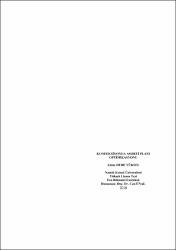| dc.contributor.author | Yüksel, Alime Dere | |
| dc.date.accessioned | 2018-05-31T12:48:31Z | |
| dc.date.available | 2018-05-31T12:48:31Z | |
| dc.date.issued | 2018 | |
| dc.identifier.uri | https://hdl.handle.net/20.500.11776/2601 | |
| dc.description.abstract | Günümüzde konfeksiyon işletmeleri faaliyetlerinin devamlılığını sağlamak ve büyüyebilmek için maliyetlerini en aza indirmek zorundadırlar. En önemli maliyetlerden biri kumaş maliyetidir. Kumaş maliyetlerinin minimizasyonu için, işletmelerde bulunan kesimhane departmanı incelenmiş ve kumaşların verimli kesilmediği saptanmıştır. Bu amaçla, problemin çözümü için doğrusal programlama tekniğinden yararlanılarak uygulama yapılmıştır. Uygulama yapılan işletmelerden gömlek, mont, pantolon, sweatshirt için örnekler alınmış ve işletmeler için değiştirilemeyecek masa uzunluğu, sipariş adetleri, serilebilecek kumaş kat sayısı, her bir ürün grubu için hesaplanan ortalama boy, fazla kesilebilecek adet gibi parametreler belirlenmiştir. Manuel olarak yapılan kesim asorti planı için doğrusal programlama yöntemiyle bir model geliştirilerek oluşturulan model için LINGO bilgisayar programı kullanılmıştır. Kullanılan program ile çalışan tarafından manuel olarak hesaplanamayacak tüm ihtimaller hesaplanabilmektedir. Model, alınan örnekler üzerinde uygulanarak manuel çözüm ile program sonucunda kullanılan kumaş miktarları karşılaştırılmıştır. Yapılan karşılaştırmalar sonucunda program ile kumaş kullanımı azaltılarak kumaş maliyeti minimizasyonu sağlanmıştır. | en_US |
| dc.description.abstract | Nowadays, apparel businesses have to cut down on their costs in order to ensure the continuity of their activities and to grow. One of the most important costs is the fabric cost. For the minimization of fabric costs, the cutting department in the enterprises was investigated and it was detected that the cut order plans could be developed. For this purpose, the solution was applied by using linear programming technique. Examples were taken from the enterprises that were implemented. A model was developed by linear programming method for the manual cut order plan and LINGO computer program was used for the created model. With the program used, all possibilities that cannot be manually calculated by the employee can be calculated. The amounts of fabric used as the result of the cut order plan were applied on the samples taken from the enterprises and the manual solution and the developed model were compared. As a result of the comparisons made, the developed model reduced the usage of the fabric and minimized the cost of the fabric | en_US |
| dc.language.iso | tur | en_US |
| dc.publisher | Namık Kemal Üniversitesi | en_US |
| dc.rights | info:eu-repo/semantics/embargoedAccess | en_US |
| dc.subject | konfeksiyon | en_US |
| dc.subject | kesimhane | en_US |
| dc.subject | asorti planı | en_US |
| dc.subject | doğrusal programlama | en_US |
| dc.subject | LINGO | en_US |
| dc.subject | apparel industry | en_US |
| dc.subject | cutting department | en_US |
| dc.subject | cut order plan | en_US |
| dc.subject | linear programing | en_US |
| dc.subject | LINGO | en_US |
| dc.title | Konfeksiyonda asorti planı optimizasyonu | en_US |
| dc.title.alternative | CUT ORDER PLANNING OPTIMIZATION IN APPAREL INDUSTRY | en_US |
| dc.type | masterThesis | en_US |
| dc.department | Enstitüler, Fen Bilimleri Enstitüsü, Tekstil Mühendisliği Ana Bilim Dalı | en_US |
| dc.relation.publicationcategory | Tez | en_US |



















